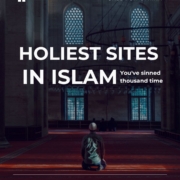What is the Holiest Site in Islam?
Among the Most Religious Sites in Islam, the holiest site is the Kaaba in Masjid al-Haram, Makkah, Saudi Arabia. Muslims around the world direct their prayers towards the Kaaba, making it the Qiblah (direction of prayer) for over 1.9 billion Muslims globally. This sacred structure is not only a symbol of unity among Muslims but also the focal point during Hajj and Umrah pilgrimages, representing deep spiritual connection and submission to Allah.
The Kaaba: The Spiritual Center of Islam
The Kaaba is a cube-shaped structure draped in black cloth (Kiswah), believed to have been originally built by Prophet Ibrahim (Abraham) and his son Prophet Ismail (Ishmael) upon Allah’s command. It is in Masjid al-Haram, the largest mosque in the world, which can accommodate millions of worshippers, especially during Hajj.
Muslims believe that the Kaaba is the “House of Allah” on Earth, and it is the first house built for the worship of the One God. This makes it the most sacred and holiest site among the Most Religious Sites in Islam, as it signifies unity, equality, and complete submission to Allah, regardless of race, nationality, or status.
Importance of Hajj and Umrah
Every year, millions of Muslims perform Hajj, one of the five pillars of Islam, which is obligatory for those who are physically and financially capable. Hajj rituals revolve around the Kaaba, where pilgrims perform Tawaf (circling the Kaaba seven times) and other acts of worship to cleanse themselves of sins and renew their faith.
For many Muslims, there is a Call for Umrah, a voluntary but deeply rewarding pilgrimage that can be performed at any time of the year. Like Hajj, Umrah involves Tawaf around the Kaaba and performing Sa’i (walking between the hills of Safa and Marwah). The spiritual significance of Umrah lies in the chance to seek forgiveness, spiritual cleansing, and closeness to Allah.
Other Important Religious Sites in Islam
While the Kaaba is the holiest, other Most Religious Sites in Islam include:
- Al-Masjid an-Nabawi in Madinah: The Prophet Muhammad’s mosque and resting place.
- Al-Aqsa Mosque in Jerusalem: The first Qiblah and the place of the Prophet’s Isra and Mi’raj (night journey).
- Masjid Quba in Madinah: The first mosque built by the Prophet Muhammad.
Final Thoughts
In the realm of the Most Religious Sites in Islam, the Kaaba in Masjid al-Haram holds the highest place in the hearts of Muslims, serving as the ultimate center for worship and unity. Whether through Hajj or responding to the Call for Umrah, visiting this sacred site is a profound spiritual journey that strengthens faith and brings Muslims closer to Allah.
If you have ever felt the yearning to visit Makkah, know that it is a spiritual call many Muslims cherish deeply, and fulfilling it can be a transformative chapter in your journey toward spiritual growth and connection with your Creator.










